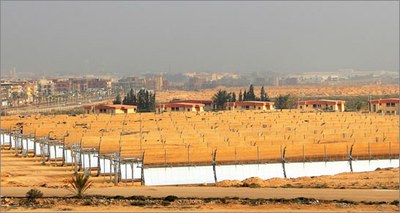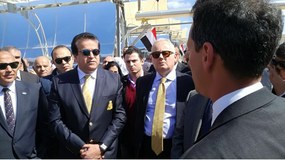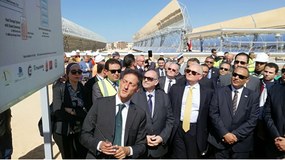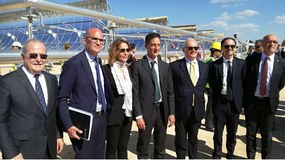Energy: North Africa, launched first thermodynamic solar plant with ENEA technology
22/3/2018
 A 10thousand m2 – approximately two football fields – where 18, 100 meter long parabolic mirrors “capture” solar radiation: these are the figures of the first thermodynamc solar plant with ENEA technology inaugurated in North Africa at the presence of the Italian Ambassador to Cairo Giampaolo Cantini, the EU Ambassador Ivan Surkos, the Egyptian Minister of Electricity and Renewable Energy Mohamed Shaker, the Ministry of High Education and Scientific Research Khalid Atef Abdul Ghaffar, and the President of the Academy of Scientific Research and Technology in Cairo (ASRT), Mahmoud Sakr.
A 10thousand m2 – approximately two football fields – where 18, 100 meter long parabolic mirrors “capture” solar radiation: these are the figures of the first thermodynamc solar plant with ENEA technology inaugurated in North Africa at the presence of the Italian Ambassador to Cairo Giampaolo Cantini, the EU Ambassador Ivan Surkos, the Egyptian Minister of Electricity and Renewable Energy Mohamed Shaker, the Ministry of High Education and Scientific Research Khalid Atef Abdul Ghaffar, and the President of the Academy of Scientific Research and Technology in Cairo (ASRT), Mahmoud Sakr.
 Located in the “City of Science and Technology” campus in Borg-el-Arab, about 40 km from Alexandria, the plant was developed by the project MATS (Multipurpose Applications by Thermodynamic Solar), coordinated by ENEA.
Located in the “City of Science and Technology” campus in Borg-el-Arab, about 40 km from Alexandria, the plant was developed by the project MATS (Multipurpose Applications by Thermodynamic Solar), coordinated by ENEA.
The plant is based on the technology conceived by Nobel prize winner Carlo Rubbia and developed by ENEA using molten salts at a maximum temperature of 550°C as a process fluid and a thermal storage, to distribute energy even in the absence of solar radiation. Combined with other traditional fuels, the plant can supply 5MW of high temperature heat, up to 1 MW of electricity and about 250 m3 of desalinated water daily, satisfying the consumption of a community of over 1000 inhabitants. The plant was integrated in the local electricity, gas and water distribution grids, even if it can also work off-grid.
 “The project MATS demonstrates both the validity of the all-italian solar thermodynamic technology, particulary the ENEA technology, and the capacity of research, university and industry to organize their competences, cooperating effectively with local communities” Tommaso Crescenzi, Head of the Solar Thermal and Thermodynamic Division, said.
“The project MATS demonstrates both the validity of the all-italian solar thermodynamic technology, particulary the ENEA technology, and the capacity of research, university and industry to organize their competences, cooperating effectively with local communities” Tommaso Crescenzi, Head of the Solar Thermal and Thermodynamic Division, said.
After the technological results obtained, from now on it’s fundamental to focus on the training of local workers for the management of the new plant, which will bring about new jobs, especially in the sector of renewables, which is strategic for North Africa”, Alberto Giaconia, project coordinator and researcher at the ENEA Laboratory of Solar technologies Engineering, said.
 “Our goal - Giaconia concluded- is transforming a semi-desert region in a technological hub, strenghtening the scientific collaboration between the European Union and Egypt and replicating this experience in other areas of North Africa and the Middle East, to promote and disseminate innovative technologies”.
“Our goal - Giaconia concluded- is transforming a semi-desert region in a technological hub, strenghtening the scientific collaboration between the European Union and Egypt and replicating this experience in other areas of North Africa and the Middle East, to promote and disseminate innovative technologies”.
The total budget of the project is 22 million euro, with a contribution from the EU of 12.5 million euro. The consortium MATS includes partners from France (CEA), Germany (Fraunhofer), Egypt (ASRT and NREA, Orascom Construction industries and Delft Environment), England (University of Cranfield), Italy (KT-Kinetics Technology of the Maire Tecnimont Group and Archimede Solar Energy).
For more information log on to:
http://www.enea.it/it/seguici/events/mats_27feb18/MATS_Brochure_v2.pdf
Or contact:
Alberto Giaconia, ENEA – Laboratory of Solar Technologies Engineering, alberto.giaconia@enea.it
